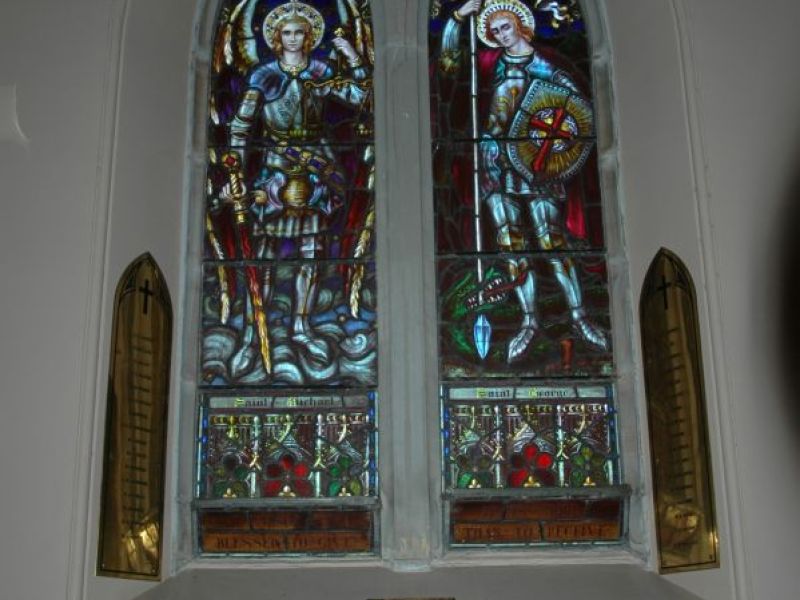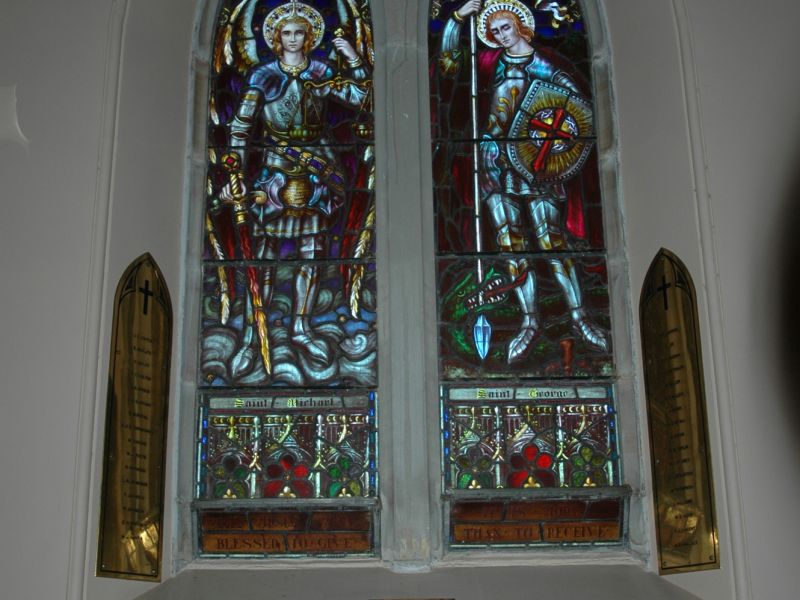Fallen Soldiers Memorial Window Unveiled in St Johns Anglican Church
The beautiful church of St John, Young has been still further adorned by a memorial window to the fallen soldiers of the parish and district, which was unveiled and dedicated during a solemn Eucharist at 10.30 on Tuesday morning (Anzac Day) 1923.
Long before the hour appointed for the service crowds gathered in the church, which was filled to over-flowing. Included in the congregation were representatives of most of the public bodies. The only invited persons were the nearest relatives of the fallen, who were accommodated in seats near the window, and as was fitting, only those near and dear to the men who made the supreme sacrifice approached the altar for communion.
Dr Radford, Bishop of Goulburn, in cope and mitre, was the celebrant and preacher, and dedicated the window. Rev S. Champion, (Rector of Young), and Rev B. North (Rector of Thuddungra), assisted at the altar. Suitable hymns were sung, and special prayers offered for the departed soldiers, for those who mourn, and for the Empire. After the Creed, the Bishop, clergy and the choir proceeded to the window, which is at the south side of the nave, singing the hymn “Oh God of Jacob”. The unveiling was performed by Maj T. Steel, the senior officer of the local militia.
The bishop then solemnly dedicated the memorial and bugler Pritchard sounded the Last Post. The memorial comprises a two-light window, beautifully coloured, and depicting the figures of St. Michael and St George. Above is the Rising Sun of the A.I.F. in the small light in a central position surmounting the memorial. Below is the inscription, “Jesus said, it is more Blessed to give than to Receive.” On brass tablets on either side of the window, surmounted by a plain Latin Cross, in black lettering, are the following names:-
| J.E.Ashton |
A.Lee |
| E.Beplate |
B.W.Marina |
| H.Bailey |
A.S.Metcalfe |
| H.E.Bolton |
G.Miller |
| G.B.Briggs |
B. F. Miller |
| A.B.Burrows |
J.Moss |
| R.Burstal |
A.C. Myall |
| A.J.Carmichael |
O.Nixon |
| W. Duncan |
G.W.Poplin |
| W.J. Foots |
W.T.Storey |
| R.Hopwood |
D.J.Staunton |
| L.R.Jennings |
W.Thompson |
| F..Johnson |
P.J.Vincent |
| F.H Johnson |
L.Williams |
| E.H. Hinton |
W.E. Wood |
| W.J.Harris |
A.B.Wallace |
| N.P. Harris |
On a polished block, placed in front of the mullion of the windows, on which stood a vase of flowers, with the following inscription on a small brass plate:
“To the Glory of God.
In thankful Remembrance of the Men of this Parish and District
who counted not their lives dear unto them,
but gave them willingly in the cause of Freedom and
Justice in the Great War 1914-1918.
“Faithful unto Death.”- Rev 2,10
Numerous wreaths were placed there as tokens of remembrance by loving hands. The processional hymn, “For Thy Children Gone Before” was sung as the choir returned to the chancel. The Bishop then delivered a most inspiring address, in the course of which he touched upon the great sacrifice which the soldiers had made to the higher life which they had been called.
His Lordship said that Anzac anniversaries were not the time for praise and glorification but the solemn remembrance and serious reflection. Returned soldiers had struck the right note by their desire for a distinctly religious type of commemoration and by their anxiety that Anzac Day should be guarded against the appetite for sport and entertainment. They had rightly protested against the tendency to use it as an ordinary holiday a day which was made sacred by sacrifice of soldier brothers.
Then followed that beautiful hymn sung usually at festivals, of martyrs and other holy days “How bright, those glorious Spirits Shine!”
The benediction and the National Anthem followed, and then that sweetly comforting hymn which is really a prayer for absent friends, “Holy Father in Thy Mercy, Keep Our Loved Ones now far Absent Neath Thy Care.” It was sung for a recessional, and as the sweet notes of the choristers rang through the church, some of those whose loved ones have passed beyond the veil silently made intercession for their soldier boys which are sleeping in other lands. They then passed out with the crowd.
The raindrops were gently falling as if the heavens were shedding tears with them_ mingled tears of pride and sadness. The military formed into line, and the band struck up a march and the procession swung off down the road.
The window is the work of Mr W. Montgomery, artist, of Melbourne, and is a fine piece of work, and compares favourably with anything in the church. The erection was carried out by Mr H.R. Blackett with satisfaction to all concerned.


